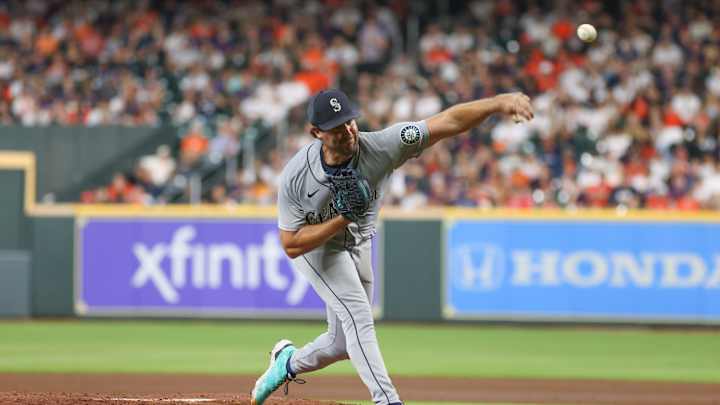Breaking Down Mariners LHP Robbie Ray With Bill Hezel of Driveline Baseball

Last December, Mariners president of baseball operations Jerry Dipoto made a huge splash, signing reigning American League Cy Young Award winner Robbie Ray to a massive deal worth up to $115 million.
Ray is known for his strikeout prowess, as well as mechanical changes he has made that have allowed him to stay in the strike zone. The left-hander has had mixed results in 2022, and added some interesting new things to his repertoire.
I sat down with Bill Hezel of Driveline Baseball to take a look at Ray’s changes in both pitch arsenal and mechanics. Driveline is a facility that looks to help players improve through use of data, research and constant iteration.
After speaking with Tanner Stokey, the director of hitting at Driveline, about the swings of Jesse Winker and Ty France, I decided to get together with Hezel to take a look at Ray.
“The most interesting thing to me about Robbie is his mechanical changes,” Hezel says. “He has gone through some drastic changes in his arm action, going from a longer arm action, shortening it up a ton, and going back to long again.”
Ray made these changes shortly before and during last season, which is a remarkable feat. Hezel gushed about how rare it is for a guy to switch up arm action in such a short time window. Ray was able to make the changes in a rapid time period, while not sacrificing the movement or command of his pitches.
In fact, the changes Ray made really improved his command. His career BB/9 was anywhere between 3.5 and 7.8, giving up way too many base runners. Although his strikeout numbers have been high his entire career, the walks torpedoed his ability to sustain his performance.
In 2021, however, Ray struck out 11.5 batters per nine innings while lowering his walk rate down to an average of 2.4. This year, his walk rate has remained low at just 3.1 per nine.
Arm action is one thing that has been studied at Driveline and other baseball facilities, and is one of the things we do know a decent amount about biomechanically.
“Whether it is a long arm action or short, it doesn’t really matter; what we are striving for is efficiency,” Hezel added.
Efficiency is what the 30-year old lefty has found, giving himself a better chance of maintaining success by throwing more strikes.
Some other changes Ray has made in his delivery are experimenting with raising his hands over his head, as well as the counter-rotation he has added. This is the move during his delivery where Ray turns his back to the hitter. Hezel says this could be a cue to keep him from flying open. This turn is one of the hallmarks of his delivery, aside from the obvious grunting.
Robbie Ray: "I definitely felt like everything was clicking tonight. The fastball was really good. The slider was as good as it's ever been. It felt like my timing, everything, was right where it needed to be."
— Daniel Kramer (@DKramer_) May 11, 2022
A look at his 10 strikeouts: pic.twitter.com/vdcp3XmelC
As for his pitch arsenal, Ray mainly relies on two pitches: a four-seam fastball and a slider. He also uses a new two-seam fastball, changeup and a curveball sparingly, which Hezel describes as “enough to keep both pitches on the scouting report.”
Ray's fastball ranks in the 48th percentile of fastball velocity and the 55th percentile in fastball spin, per Baseball Savant. Driveline has this pitch graded extremely well, coming in at 142 in their Stuff+ metric (100 is league average).
Hezel says it seems Ray has started cutting his fastball more this season, potentially the reason for the drop in velocity. This has decreased the arm-side movement on his four-seam fastball.
Ray’s newest toy is a two-seam fastball that has majorly helped turn his 2022 campaign around. This isn’t exactly a brand-new offering from him, but one he has brought back into the fold this season. According to Baseball Savant, the last time he used the pitch was with the Diamondbacks in 2019.
The pitch does not grade very well by Driveline’s Stuff+ system, ranking coming in at a 64. When he used it in previous years, there was not enough separation between his four-seamer and two-seamer. While both pitches are almost identical in velocity, they have much different movement profiles, which has made Ray's two-seamer effective in playing off of his four-seamer.
“He has opened up more room for the sinker to play and to be a different fastball. The two pitches are blending together less,” Hezel says.
While the results have been good so far, the pitch, as noted, doesn’t grade out very well. We should expect to see some regression on the pitch, but it can still be a valuable piece to induce double plays and weak contact.
Ray’s biggest weapon is arguably his deadly slider. While most of the league has gone to a big sweeping slider, his slider in particular is more of a power cutter. Hezel says the pitch will literally back up sometimes, with very little horizontal movement. Driveline has the pitch at a 105 on Stuff+.
Robbie Ray, Wicked 89mph Slider. 🤢 pic.twitter.com/na6sLutOBJ
— Rob Friedman (@PitchingNinja) July 10, 2022
According to Hezel, there are two reasons for its great effectiveness: the command and velocity. Ray throws his slider with an average of 87 MPH and commands it very well.
Although Ray has had a very up-and-down season in 2022, there is plenty of reason to remain optimistic. Seattle needs Ray to find form again to help snap its 20-year playoff drought this fall. By adding rotation mate Luis Castillo at the trade deadline, there is hope for a two-headed monster that can do damage in October.
